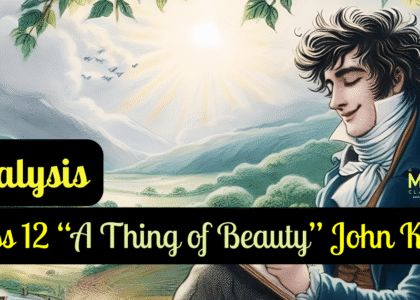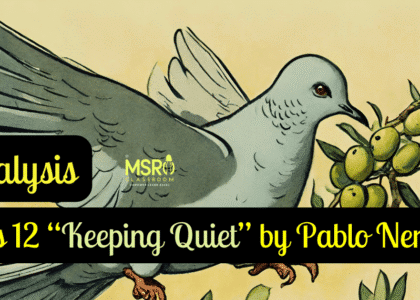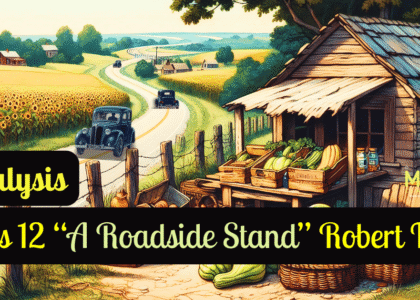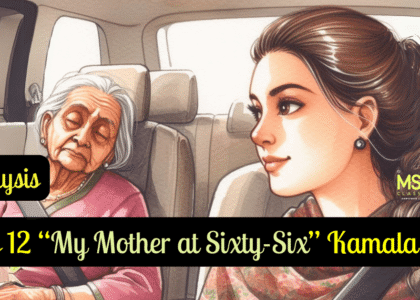Detailed Aunt Jennifer’s Tigers line-by-line Explanation, Summary, Analysis, Literary Devices, Extract-Based Questions.
Poem 5- Aunt Jennifer’s Tigers by Adrienne Rich:
Adrienne Rich
Adrienne Rich (1929-2012) was a prolific American poet, essayist, and feminist. Her work is known for its unapologetic exploration of complex themes, including gender, identity, and social justice. Rich’s poetry often challenged societal norms and power structures, advocating for women’s rights and equality.
“Aunt Jennifer’s Tigers” was first published in 1951. It appeared in her first published book of poems, A Change of World.

Table of Contents
Supplementary Reader: Class 12 ‘Vistas‘
Vocabulary:
| Band: A ring worn on the finger. Certainty: Firm conviction about something. Chivalric: Noble and dignified behaviour, highlighting confidence and grace. Denizens: Inhabitants of a place. Fluttering: Quick, light, irregular motions. Ivory: A hard, white substance from animal tusks. Ordeals: Severe trials or hardships. Pace: Steady and consistent movement. Panel: Flat or curved component of a surface. Prance: Move with high steps out of pride or excitement. Screen: Tapestry or embroidery. Sleek: Smooth and glossy appearance. Topaz: A yellow or brown gemstone. |
Summary ‘Aunt Jennifer’s Tigers’:
‘Aunt Jennifer’s Tigers’ by Adrienne Rich is a short but powerful poem that explores themes of oppression, marriage, and the enduring strength of art. The poem depicts Aunt Jennifer engaged in needlework, creating a tapestry with tigers. These tigers symbolise her inner desires and aspirations. The tigers are described as bold and unafraid, representing a stark contrast to Aunt Jennifer’s life, which is weighed down by the oppressive presence of her husband (Uncle).
The poem hints at Aunt Jennifer’s marriage, where she feels trapped and powerless, as suggested by the reference to the “massive weight” of her wedding band. When Aunt Jennifer dies, the poem means that the tigers she creates in her art will outlive her and remain a testament to her inner strength and desires despite the constraints imposed on her by her marriage.
To summarise, ‘Aunt Jennifer’s Tigers’ explores the tension between personal aspirations and societal constraints, highlighting the lasting impact of art and creativity to express inner struggles and desires.

SHOP: MSRO SMART NOTES: Class 12 English Literature
Central Idea: Aunt Jennifer’s Tigers:
The central idea of “Aunt Jennifer’s Tigers” revolves around women’s oppression and constraint within patriarchal societies. Through the metaphor of Aunt Jennifer’s embroidered tigers, the poem depicts her desire for freedom and empowerment, contrasted with her life of submission and fear under her husband’s dominance. The tigers symbolise Aunt Jennifer’s aspirations for strength and autonomy, which are unattainable in her marital reality.
Adrienne Rich explores the tension between personal creativity and societal expectations, highlighting the struggle for women to assert themselves and find agency in a world that often limits their expression and stifles their individuality. Ultimately, the poem highlights the pervasive impact of gender inequality and the longing for liberation within oppressive structures.
Analysis and Explanation of ‘Aunt Jennifer’s Tigers’ for Auditory Learners:
Duration: 16 minutes
Chapters/time stamps with subtitles are available.
Aunt Jennifer’s Tigers Line -by-Line Explanation:
- “Aunt Jennifer’s tigers prance across a screen,”
The poem introduces the central character, Aunt Jennifer, and her artistic creation, the tigers. The term “prance” suggests a graceful and confident movement, emphasising the tigers’ fearlessness and autonomy.
- “Bright topaz denizens of a world of green.”
The tigers are described as “bright topaz,” indicating their vibrant and precious nature. They are the inhabitants (“denizens”) of a world filled with lush and vivid green imagery, further emphasising their confidence and freedom.
- “They do not fear the men beneath the tree;”
The tigers are unafraid of the men who are positioned beneath the tree. This contrast highlights the tigers’ courage and independence.
- “They pace in sleek chivalric certainty.”
The tigers move with elegance and knightly (“chivalric”) confidence, reinforcing their fearless and noble demeanour.
- “Aunt Jennifer’s fingers fluttering through her wool” –
Aunt Jennifer’s fingers are described as “fluttering,” suggesting nervousness or unease. She is engaged in creating art, explicitly weaving her wool.
- “Find even the ivory needle hard to pull.” –
Aunt Jennifer struggles to pull the ivory needle through the wool, indicating her physical and emotional difficulty in expressing herself and pursuing her artistic endeavours.
- “The massive weight of Uncle’s wedding band”
The heavy wedding band of Aunt Jennifer’s husband symbolises her marital commitment and the oppressive nature of her marriage.
- “Sits heavily upon Aunt Jennifer’s hand.”
The wedding band is burdensome and weighs down Aunt Jennifer, both physically and metaphorically, symbolising the constraints and expectations of her role as a wife.
- “When Aunt is dead, her terrified hands will lie”
The poem suggests that Aunt Jennifer’s fear and anxiety will persist even after her death, as her “terrified hands” will remain.
- “Still ringed with ordeals she was mastered by.”
Her hands will be surrounded (“ringed”) by the difficulties and challenges (“ordeals”) she faced during her life. The word “mastered” suggests that these challenges controlled or subdued her.
- “The tigers in the panel that she made”
The tigers in her tapestry, created by Aunt Jennifer, represent her artistic expression and inner desires.
- “Will go on prancing, proud and unafraid.” –
Despite Aunt Jennifer’s struggles, her art will endure, and the tigers will continue to prance with pride and fearlessness, symbolising her enduring legacy of strength and independence.
Questions Answers ‘Aunt Jennifer’s Tigers’:
Textbook Question Answers:
Q1: How do ‘denizens’ and ‘chivalric’ add to our understanding of the tiger’s attitudes?
A1: The words “denizens” and “chivalric” in the poem “Aunt Jennifer’s Tigers” by Adrienne Rich contribute to our understanding of the tiger’s attitudes by providing insight into their demeanour and character.
“Denizens” implies that the tigers are not merely visitors in their world but are inhabitants, suggesting a sense of belonging and ownership. This word choice underscores the tigers’ confidence and comfort in their environment, mirroring Aunt Jennifer’s desire for a similar sense of ownership in her life.
“Chivalric” suggests a code of conduct associated with knights during the medieval period. By describing the tigers as “chivalric,” the poem attributes them to a sense of honour, bravery, and gallantry. This word choice emphasises the tigers’ fearlessness and noble, moral behaviour, reinforcing the idea of strength and independence.
Together, these words enhance the image of the tigers as proud, self-assured beings, which contrasts sharply with Aunt Jennifer’s struggles and submission, highlighting her longing for the attributes embodied by the tigers.
Q2: Why do you think Aunt Jennifer’s hands are ‘fluttering through her wool’ in the second stanza? Why is she finding the needle so hard to pull?
A2: In the second stanza of the poem ‘Aunt Jennifer’s Tigers’ by Adrienne Rich, the description of Aunt Jennifer’s “fluttering” hands and her difficulty in pulling the needle can be interpreted as symbolic of her emotional and physical struggles within her marriage and the constraints of her societal role.
Fluttering Hands: Aunt Jennifer’s “fluttering” hands suggest nervousness, anxiety, or a lack of confidence. This could reflect her emotional state and the unease she experiences in her married life. “fluttering” implies a sense of agitation, perhaps stemming from the pressures and expectations placed upon her as a wife.
Hard to Pull the Needle: The difficulty in pulling the needle can symbolise the weight of her marital obligations and the oppressive nature of her marriage. The “hard to pull” needle may represent her challenges in expressing herself, pursuing her passions, or asserting her independence while fulfilling her expected role as a wife.
In essence, these lines convey Aunt Jennifer’s inner turmoil and the struggles she faces within the context of her marriage. Her “fluttering” hands and the challenging needle symbolise the emotional and physical burdens that she carries, which are made more difficult by the traditional gender roles and societal expectations of her time.
Q3: What is suggested by the image ‘massive weight of Uncle’s wedding band’?
A3: The image of the “massive weight of Uncle’s wedding band” in the poem “Aunt Jennifer’s Tigers” by Adrienne Rich suggests several things:
- Symbol of Oppression: The wedding band symbolises Aunt Jennifer’s oppressive marriage. Its “massive weight” conveys that her marital obligations and the expectations of her role as a wife are burdensome and suffocating. It’s as if the weight of the wedding band symbolises the weight of the traditional gender roles and societal expectations that she is forced to bear.
- Power Imbalance: The description of the wedding band as “massive” implies a power imbalance within the marriage. It suggests that Uncle may have had a dominant or controlling role, contributing to Aunt Jennifer’s feelings of constraint and subjugation.
- Emotional Burden: The “massive weight” of the wedding band is a metaphor for the emotional burden that Aunt Jennifer carries due to her marriage. It suggests that the expectations and responsibilities associated with her role as a wife have become oppressive and suffocating.
- Lack of Autonomy: The weight of the wedding band implies a lack of autonomy and personal freedom. Aunt Jennifer may feel trapped and weighed down by her marital obligations, unable to fully express herself or pursue her desires.
In sum, the image of the “massive weight of Uncle’s wedding band” highlights the poem’s theme: the suffocating and constraining nature of Aunt Jennifer’s marriage and the societal expectations she grapples with. It symbolises her sense of oppression and her yearning for independence and self-expression.
Q4: Of What or of whom is Aunt Jennifer terrified in the third stanza?
A4: In the third stanza of the poem “Aunt Jennifer’s Tigers” by Adrienne Rich, Aunt Jennifer is not terrified of a specific person or thing. Instead, the line “When Aunt is dead, her terrified hands will lie” suggests that Aunt Jennifer’s hands themselves are described as “terrified.” This use of personification assigns human emotions to her hands, which is a metaphor for the fear and anxiety that she experiences during her life.
The term “terrified hands” symbolises the emotional turmoil and constraints that Aunt Jennifer endured throughout her marriage. It represents the fear, anxiety, and oppression that she felt in her marital relationship. The use of the word “terrified” emphasises the emotional toll of her circumstances and the extent to which her life was marked by fear and unease. The poem does not specify a particular source of terror, but it is implied to be the result of her stifling marriage and societal expectations.
Q5: What are the ‘ordeals’ Aunt Jennifer is surrounded by? Why is it significant that the poet uses the word ‘ringed’? What are the meanings of the word ‘ringed’ in the poem?
A5: The word “ordeals” in the poem “Aunt Jennifer’s Tigers” by Adrienne Rich refers to the challenges, difficulties, and hardships that Aunt Jennifer faced throughout her life, particularly in the context of her marriage and societal expectations. These ordeals could include the emotional and psychological burdens she endured as a result of her marital role and the constraints placed upon her as a woman in a patriarchal society. The word “ordeals” signifies the struggles and oppression she experienced.
The poet’s use of the word “ringed” is significant for several reasons:
- Symbol of Confinement: “Ringed” implies that Aunt Jennifer was surrounded and confined by these ordeals. It suggests that she was encircled by the difficulties and constraints, unable to escape them. This word choice emphasises the suffocating nature of the challenges she faced.
- Symbol of Entrapment: “Ringed” also conveys a sense of entrapment or being engaged, which aligns with the theme of Aunt Jennifer’s constrained existence. It symbolises her lack of freedom and autonomy within the confines of her marriage and societal expectations.
- Repetition of the Wedding Band: The word “ringed” also serves as a subtle play on words, linking to the “massive weight of Uncle’s wedding band” mentioned earlier in the poem. The repetition of the ring imagery reinforces the idea of the burden and oppression associated with her marital obligations.
In essence, the word “ringed” highlights the theme of confinement, oppression, and the emotional burdens that Aunt Jennifer endured. It signifies her struggle to break free from the constraints of her marriage and societal expectations, which is the poem’s central theme.
Q6: Why do you think Aunt Jennifer created animals that are so different from her character? What might the poet be suggesting through this difference?
A6: Aunt Jennifer’s creation of tigers in her tapestry that are so different from her character can be interpreted as a form of artistic expression and an escape from the constraints of her life. The poet, Adrienne Rich, uses this contrast to convey several possible suggestions:
- Desire for Freedom: Aunt Jennifer’s creation of fearless and majestic tigers may symbolise her inner longing for freedom and independence. The stark contrast between her timid and oppressed persona and the mighty tigers highlights her yearning for qualities she might feel are missing in her life.
- Artistic Liberation: Through her art, Aunt Jennifer can express aspects of herself that she might find difficult to manifest in her everyday life. The act of creating these fierce tigers allows her to break free from the societal expectations and limitations imposed on her as a woman in a patriarchal society.
- Sublimation of Desires: The tigers in her art can be seen as a way for Aunt Jennifer to sublimate (control) her desires for strength and autonomy. She can channel her yearnings and frustrations through her artistic creation into something tangible and enduring.
- Legacy of Independence: The poet may also suggest that one can leave a lasting legacy of strength and courage despite adversity and constraint. The tiger’s unafraid and proud demeanour in her art outlives her, serving as a testament to her enduring spirit and desire for a different life.
To conclude, the poet may be using the difference between Aunt Jennifer and her artistic creations to illustrate the power of art to express suppressed desires and seek personal liberation. It emphasises the potential for art to transcend the limitations of one’s circumstances and leave a lasting legacy of individual strength and independence.
Q7: Interpret the symbols found in this poem.
A7: Refer to the section “Symbolism” above.
Q8: Do you sympathise with Aunt Jennifer? What is the attitude of the speaker towards Aunt Jennifer?
A8: Yes. Like many readers, I sympathise with Aunt Jennifer in Adrienne Rich’s poem “Aunt Jennifer’s Tigers.” The speaker’s attitude towards Aunt Jennifer is one of empathy and understanding. The poem portrays Aunt Jennifer as a woman trapped in a patriarchal society, symbolised by her marriage to Uncle. The heavy weight of her wedding band symbolises the oppressive constraints she feels.
Aunt Jennifer’s creation of the tigers, depicted as fearless and free, represents her inner longing for independence and strength. Despite her struggles, Aunt Jennifer finds solace and empowerment through her art. The speaker acknowledges Aunt Jennifer’s resilience and the enduring legacy of her creativity, even in the face of adversity.

SHOP: MSRO SMART NOTES: Class 12 English Literature
Extract Based Question ‘Aunt Jennifer’s Tigers’:
Extract 1
“Aunt Jennifer’s tigers prance across a screen,
Quatrain 1
Bright topaz denizens of a world of green.
They do not fear the men beneath the tree;
They pace in sleek chivalric certainty.”
Q1: What is the subject matter of “Aunt Jennifer’s Tigers”?
A1: The subject matter of the poem is Aunt Jennifer’s creation of tigers depicted in her artwork.
Q2: Describe the imagery used in the poem’s first two lines.
A2: The imagery portrays Aunt Jennifer’s tigers as vibrant and lively, described as “prancing across a screen” and “Bright topaz denizens of a world of green.”
Q3: How do the tigers contrast with the men mentioned in the poem?
A3: The tigers are depicted as fearless and confident, pacing with “sleek chivalric certainty,” while the men beneath the tree are portrayed as potentially threatening or oppressive, as the tigers do not fear them.
Q4: What symbolic meaning might be attached to Aunt Jennifer’s fingers fluttering through her wool?
A5: Aunt Jennifer’s fingers struggling to work with the wool and needle may symbolise her struggle with the constraints and limitations imposed upon her by society, particularly her marriage.
Q5: What does the wedding band symbolise in the poem?
A5: The wedding band symbolises Aunt Jennifer’s marriage and the weight of the patriarchal expectations and oppression she feels within it.
Q6: What is the speaker’s attitude towards Aunt Jennifer and her creation?
A6: The speaker expresses sympathy and admiration for Aunt Jennifer, acknowledging her struggles within her marriage and celebrating her resilience and artistic expression as represented by her creation of the tigers.
Extract 2:
“Aunt Jennifer’s fingers fluttering through her wool
Quatrain 2
Find even the ivory needle hard to pull.
The massive weight of Uncle’s wedding band
Sits heavily upon Aunt Jennifer’s hand.”
Q1: What is the significance of Aunt Jennifer’s fingers fluttering through her wool?
A1: Aunt Jennifer’s fluttering fingers suggest her struggle and difficulty in completing her needlework, possibly indicating her physical weakness or emotional turmoil.
Q2: What does the difficulty of pulling the ivory needle imply?
A2: Aunt Jennifer’s difficulty pulling the needle implies daily challenges and obstacles, possibly related to her oppressive marriage or societal expectations.
Q3: What does the wedding band symbolise?
A3: The wedding band symbolises Aunt Jennifer’s marriage to Uncle and the burdensome responsibilities and constraints it imposes upon her, both emotionally and physically.
Q4: How does the weight of the wedding band affect Aunt Jennifer?
A4: The weight of the wedding band suggests the oppressive nature of Aunt Jennifer’s marriage, weighing heavily on her hand and symbolising the burden of patriarchal expectations and obligations she feels.
Q5: What emotions might Aunt Jennifer experience as she struggles with the wedding band?
A5: Aunt Jennifer may experience feelings of suffocation, confinement, or resignation as she grapples with the weight of the wedding band and the constraints it represents.
Q6: How does the imagery in these lines contribute to the overall theme of the poem?
A6: The imagery of Aunt Jennifer’s fluttering fingers and the heavy wedding band reinforces the theme of Aunt Jennifer’s oppression and struggle within her marriage, highlighting the emotional and physical toll it takes on her.
Extract 3:
“When Aunt is dead, her terrified hands will lie
Quatrain 3
Still ringed with ordeals she was mastered by.
The tigers in the panel that she made
Will go on prancing, proud and unafraid.”
Q1: What does the phrase “her terrified hands” suggest?
A1: The phrase suggests that even in death, Aunt Jennifer’s hands retain the fear and anxiety she experienced during her lifetime, symbolising the lasting impact of her struggles.
Q2: What does Aunt Jennifer’s hands being “ringed with ordeals” signify?
A2: It signifies that Aunt Jennifer’s life was filled with hardships and challenges, suggesting that her struggles were central to her existence.
Q3: What does the speaker imply about Aunt Jennifer’s relationship with her creations after her death?
A3: The speaker implies that Aunt Jennifer’s artistic creations, represented by the tigers in her panel, will outlast her and continue to exist independently, unaffected by her suffering.
Q4: How are the tigers described in the final line?
A4: The tigers are described as “prancing, proud and unafraid,” suggesting that they embody strength, confidence, and fearlessness, contrasting with Aunt Jennifer’s feelings of fear and oppression.
Q5: What might the tigers symbolise in the context of the poem?
A5: The tigers symbolise Aunt Jennifer’s inner desires for freedom, strength, and independence, as well as her artistic expression and creativity that transcends her struggles.
Q6: How does the speaker reflect on Aunt Jennifer’s legacy through these lines?
A6: The speaker reflects on Aunt Jennifer’s legacy by suggesting that her art will endure beyond her life, serving as a testament to her strength and resilience despite her challenges.





